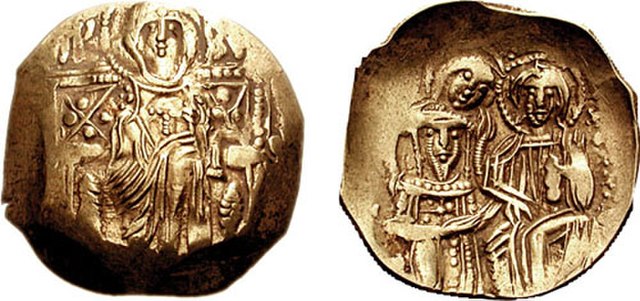Michael VIII Palaiologos or Palaeologus reigned as Byzantine emperor from 1261 until his death in 1282, and previously as the co-emperor of the Empire of Nicaea from 1259 to 1261. Michael VIII was the founder of the Palaiologan dynasty that would rule the Byzantine Empire until the Fall of Constantinople in 1453. He recovered Constantinople from the Latin Empire in 1261 and transformed the Empire of Nicaea into a restored Byzantine Empire. His reign saw considerable recovery of Byzantine power, including the enlargement of the Byzantine army and navy. It also included the reconstruction of the city of Constantinople, and the increase of its population. His re-establishment of the University of Constantinople contributed to the Palaeologan Renaissance, a cultural flowering between the 13th and 15th centuries.
15th-century miniature of Michael VIII, National Library of Russia.
Imperial eagle in Mystras. In 1263 the Latins ceded Mystras as ransom for William II of Villehardouin, and Michael VIII Palaeologus made the city the seat of the new Despotate of Morea, ruled by his relatives.
The restored Byzantine Empire in 1265 (William R. Shepherd, Historical Atlas, 1911)
Coin of Michael VIII, depicting the Virgin Mary rising over the walls of Constantinople, in commemoration of the capture of the city over the Latins.
The Empire of Nicaea or the Nicene Empire was the largest of the three Byzantine Greek rump states founded by the aristocracy of the Byzantine Empire that fled when Constantinople was occupied by Western European and Venetian armed forces during the Fourth Crusade, a military event known as the Sack of Constantinople. Like the other Byzantine rump states that formed due to the 1204 fracturing of the empire, such as the Empire of Trebizond and the Despotate of Epirus, it was a continuation of the eastern half of the Roman Empire that survived well into the medieval period. A fourth state, known in historiography as the Latin Empire, was established by an army of Crusaders and the Republic of Venice after the capture of Constantinople and the surrounding environs.
Nicaea city wall, Lefke gate; Iznik, Turkey
Coin issued by Michael VIII Palaeologus to celebrate the liberation of Constantinople from the Latin army, and the restoration of the Byzantine Empire.






